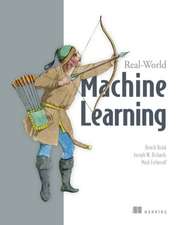Advances in Self-Organizing Maps and Learning Vector Quantization: Proceedings of the 10th International Workshop, WSOM 2014, Mittweida, Germany, July, 2-4, 2014: Advances in Intelligent Systems and Computing, cartea 295
Editat de Thomas Villmann, Frank-Michael Schleif, Marika Kaden, Mandy Langeen Limba Engleză Paperback – 26 iun 2014
This 10th WSOM brought together more than 50 researchers, experts and practitioners in the beautiful small town Mittweida in Saxony (Germany) nearby the mountains Erzgebirge to discuss new developments in the field of unsupervised self-organizing vector quantization systems and learning vector quantization approaches for classification. The book contains the accepted papers of the workshop after a careful review process as well as summaries of the invited talks. Among these book chapters there are excellent examples of the use of self-organizing maps in agriculture, computer science, data visualization, health systems, economics, engineering, social sciences, text and image analysis and time series analysis. Other chapters present the latest theoretical work on self-organizing maps as well as learning vector quantization methods, such as relating those methods to classical statistical decision methods.
All the contribution demonstrate that vector quantization methods cover a large range of application areas including data visualization of high-dimensional complex data, advanced decision making and classification or data clustering and data compression.
Din seria Advances in Intelligent Systems and Computing
- 20%
 Preț: 1120.90 lei
Preț: 1120.90 lei - 20%
 Preț: 1090.59 lei
Preț: 1090.59 lei - 20%
 Preț: 1324.07 lei
Preț: 1324.07 lei - 20%
 Preț: 1989.79 lei
Preț: 1989.79 lei - 20%
 Preț: 1946.92 lei
Preț: 1946.92 lei - 18%
 Preț: 1273.28 lei
Preț: 1273.28 lei - 20%
 Preț: 2264.51 lei
Preț: 2264.51 lei - 20%
 Preț: 1337.27 lei
Preț: 1337.27 lei - 20%
 Preț: 1297.67 lei
Preț: 1297.67 lei - 20%
 Preț: 1315.82 lei
Preț: 1315.82 lei - 20%
 Preț: 1310.88 lei
Preț: 1310.88 lei - 20%
 Preț: 1302.62 lei
Preț: 1302.62 lei - 20%
 Preț: 882.20 lei
Preț: 882.20 lei - 20%
 Preț: 1305.93 lei
Preț: 1305.93 lei - 20%
 Preț: 1629.32 lei
Preț: 1629.32 lei - 20%
 Preț: 1345.49 lei
Preț: 1345.49 lei - 18%
 Preț: 1227.52 lei
Preț: 1227.52 lei - 18%
 Preț: 1290.64 lei
Preț: 1290.64 lei - 20%
 Preț: 1041.10 lei
Preț: 1041.10 lei - 20%
 Preț: 1034.52 lei
Preț: 1034.52 lei - 20%
 Preț: 1298.50 lei
Preț: 1298.50 lei - 20%
 Preț: 1330.67 lei
Preț: 1330.67 lei - 20%
 Preț: 1483.28 lei
Preț: 1483.28 lei - 20%
 Preț: 1971.64 lei
Preț: 1971.64 lei - 20%
 Preț: 1006.48 lei
Preț: 1006.48 lei - 20%
 Preț: 1471.75 lei
Preț: 1471.75 lei - 20%
 Preț: 1471.56 lei
Preț: 1471.56 lei - 20%
 Preț: 1454.40 lei
Preț: 1454.40 lei - 20%
 Preț: 1494.84 lei
Preț: 1494.84 lei - 20%
 Preț: 1269.64 lei
Preț: 1269.64 lei - 20%
 Preț: 1481.64 lei
Preț: 1481.64 lei - 20%
 Preț: 1192.08 lei
Preț: 1192.08 lei - 20%
 Preț: 1298.50 lei
Preț: 1298.50 lei - 20%
 Preț: 1489.07 lei
Preț: 1489.07 lei - 20%
 Preț: 825.78 lei
Preț: 825.78 lei - 20%
 Preț: 1649.93 lei
Preț: 1649.93 lei - 20%
 Preț: 1463.49 lei
Preț: 1463.49 lei - 20%
 Preț: 1438.77 lei
Preț: 1438.77 lei - 20%
 Preț: 1474.22 lei
Preț: 1474.22 lei - 20%
 Preț: 1298.50 lei
Preț: 1298.50 lei - 20%
 Preț: 1327.35 lei
Preț: 1327.35 lei - 20%
 Preț: 1973.31 lei
Preț: 1973.31 lei - 18%
 Preț: 947.04 lei
Preț: 947.04 lei - 18%
 Preț: 1441.39 lei
Preț: 1441.39 lei - 20%
 Preț: 638.55 lei
Preț: 638.55 lei - 20%
 Preț: 1320.76 lei
Preț: 1320.76 lei - 20%
 Preț: 1948.56 lei
Preț: 1948.56 lei
Preț: 1443.86 lei
Preț vechi: 1804.82 lei
-20% Nou
Puncte Express: 2166
Preț estimativ în valută:
276.31€ • 300.04$ • 232.10£
276.31€ • 300.04$ • 232.10£
Carte tipărită la comandă
Livrare economică 22 aprilie-06 mai
Preluare comenzi: 021 569.72.76
Specificații
ISBN-13: 9783319076942
ISBN-10: 3319076949
Pagini: 328
Ilustrații: XII, 314 p. 114 illus., 81 illus. in color.
Dimensiuni: 155 x 235 x 17 mm
Greutate: 0.46 kg
Ediția:2014
Editura: Springer International Publishing
Colecția Springer
Seria Advances in Intelligent Systems and Computing
Locul publicării:Cham, Switzerland
ISBN-10: 3319076949
Pagini: 328
Ilustrații: XII, 314 p. 114 illus., 81 illus. in color.
Dimensiuni: 155 x 235 x 17 mm
Greutate: 0.46 kg
Ediția:2014
Editura: Springer International Publishing
Colecția Springer
Seria Advances in Intelligent Systems and Computing
Locul publicării:Cham, Switzerland
Public țintă
ResearchCuprins
How Many Dissimilarity/Kernel Self Organizing Map Variants Do We Need.- Dynamic formation of self-organizing maps.- MS-SOM: Magnitude Sensitive Self-Organizing Maps.- Bagged Kernel SOM.- Probability ridges and distortion flows: Visualizing multivariate time series using a variational Bayesian manifold learning method.- Short review of dimensionality reduction methods based on stochastic neighbour embedding.- Attention based Classification Learning in GLVQ and Asymmetric Classification Error Assessment.-Visualization and Classification of DNA sequences using Pareto learning Self Organizing Maps based on Frequency and Correlation Coefficient.- Probabilistic prototype classification using t-norms.- Rejection Strategies for Learning Vector Quantization – a Comparison of Probabilistic and Deterministic Approaches.- Comparison of spectrum cluster analysis with PCA and spherical SOM and related issues not amenable to PCA.- Exploiting the structures of the U-matrix.- Partial Mutual Information for Classification Analysis of Gene expression Data by Learning Vector Quantization.- Composition of Learning Patterns using Spherical Self-Organizing Maps in Image Analysis with Subspace Classifier.- Self-Organizing Map for the Prize-Collecting Traveling Salesman Problem.- A Survey of SOM-based Active Contour Models for Image Segmentation.- Biologically Plausible SOM Representation of the Orthographic Form of 50,000 French Words.- Prototype-based classifiers and their application in the life sciences.- Generative versus discriminative prototype based classification.- Some room for GLVQ: Semantic Labeling of occupancy gridmaps.- Anomaly detection based on confidence intervals using SOM with an application to Health Monitoring.- RFSOM - Extending Self-Organizing feature Maps with adaptive metrics to combine spatial and textural features for body pose estimation.- Beyond Standard Metrics - On the Selection and Combination of Distance Metrics for an Improved.- Classification of Hyperspectral Data.- The Sky Is Not the Limit.- Development of Target Reaching Gesture Map in the Cortex and Its Relation to the Motor Map: A Simulation Study.- A Concurrent SOM-based Chan-Vese Model for Image Segmentation.- Text mining of life-philosophicl insights.- SOMbrero: an R Package for Numeric and Non-numeric Self-Organizing Maps.- K-Nearest Neighbor Nonnegative Matrix Factorization for Learning a Mixture of Local SOM Models.
Textul de pe ultima copertă
The book collects the scientific contributions presented at the 10th Workshop on Self-Organizing Maps (WSOM 2014) held at the University of Applied Sciences Mittweida, Mittweida (Germany, Saxony), on July 2–4, 2014. Starting with the first WSOM-workshop 1997 in Helsinki this workshop focuses on newest results in the field of supervised and unsupervised vector quantization like self-organizing maps for data mining and data classification.
This 10th WSOM brought together more than 50 researchers, experts and practitioners in the beautiful small town Mittweida in Saxony (Germany) nearby the mountains Erzgebirge to discuss new developments in the field of unsupervised self-organizing vector quantization systems and learning vector quantization approaches for classification. The book contains the accepted papers of the workshop after a careful review process as well as summaries of the invited talks. Among these book chapters there are excellent examples of the use of self-organizing maps in agriculture, computer science, data visualization, health systems, economics, engineering, social sciences, text and image analysis, and time series analysis. Other chapters present the latest theoretical work on self-organizing maps as well as learning vector quantization methods, such as relating those methods to classical statistical decision methods.
All the contribution demonstrate that vector quantization methods cover a large range of application areas including data visualization of high-dimensional complex data, advanced decision making and classification or data clustering and data compression.
This 10th WSOM brought together more than 50 researchers, experts and practitioners in the beautiful small town Mittweida in Saxony (Germany) nearby the mountains Erzgebirge to discuss new developments in the field of unsupervised self-organizing vector quantization systems and learning vector quantization approaches for classification. The book contains the accepted papers of the workshop after a careful review process as well as summaries of the invited talks. Among these book chapters there are excellent examples of the use of self-organizing maps in agriculture, computer science, data visualization, health systems, economics, engineering, social sciences, text and image analysis, and time series analysis. Other chapters present the latest theoretical work on self-organizing maps as well as learning vector quantization methods, such as relating those methods to classical statistical decision methods.
All the contribution demonstrate that vector quantization methods cover a large range of application areas including data visualization of high-dimensional complex data, advanced decision making and classification or data clustering and data compression.
Caracteristici
Covers newest theoretical developments for self-organizing maps and learning vector quantization Presents computational aspects and excellent applications for data mining and visualization in several application areas Contains refereed papers presented at the Workshop on Self-Organizing Maps (WSOM 2014) held at the University of Applied Sciences Mittweida, Germany, on July 2-4, 2014
















